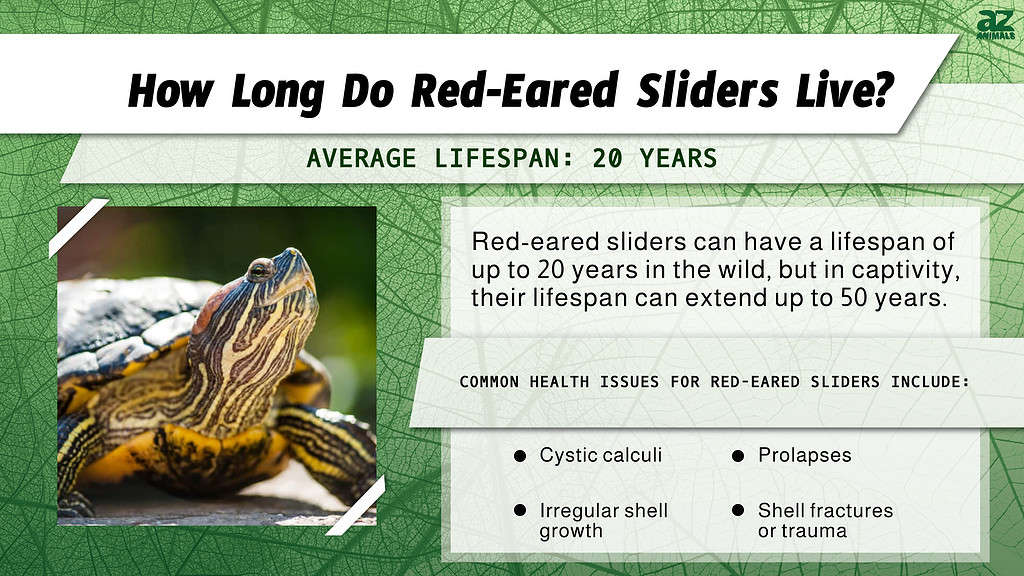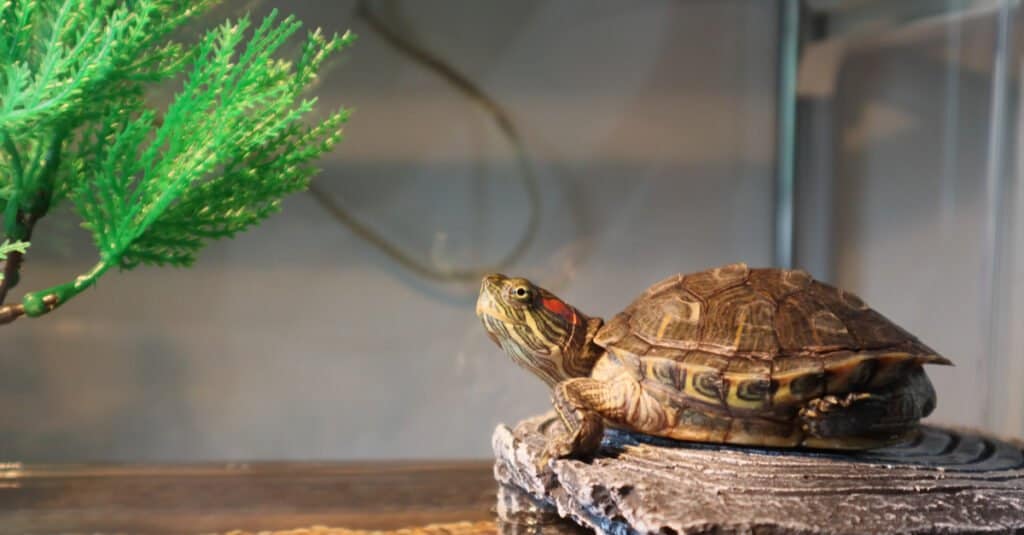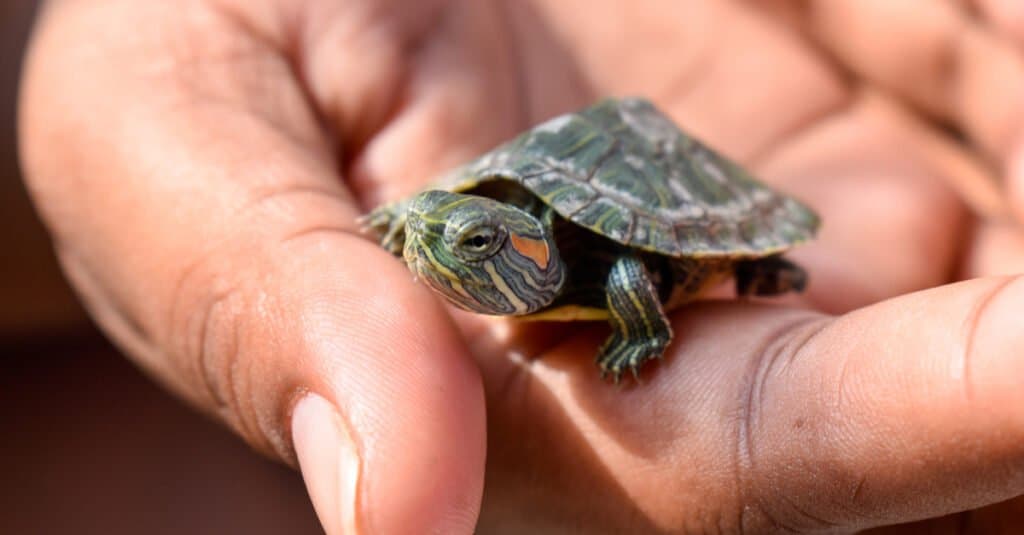
Thanks to their small size and low maintenance, red-eared sliders are both adorable and incredibly adaptable, making them one of the most popular pet turtles. You’ll instantly be able to recognize these little turtles thanks to the red lines that appear near their ears. They actually got their name from both these red markings and their ability to slide off surfaces into the water.
These little turtles are one of the most popular pets in the United States! Curious to find out more about them, such as the length of the red-eared slider lifespan? Let’s dive into this semiaquatic species and find out how long red-eared sliders live.
The Rundown on Red Eared Sliders

Red-eared sliders are omnivores; they eat both vegetative matter/aquatic plants and animal protein.
©Mark Leung/Shutterstock.com
The red-eared slider, scientifically known as the Trachemys scripta elegans, is a semi-aquatic turtle in the Emydidaw family.
Red-eared sliders may be found throughout the Mississippi Valley of the United States, particularly in West Virginia, Ohio, Texas, Louisiana, Tennessee, Kansas, Missouri, and Illinois – just to name a few. Asia and Australia are home to a sizable portion of their population as well.
However, owing to Antarctica’s conditions, there are no red-eared sliders in this area of the world. Freshwater and slow-moving lakes and ponds with maximum sun exposure are ideal habitats for these turtles.
Despite being such a popular pet in America, red-eared sliders are one of the most invasive turtle species. They are even in the top 100 invasive species on the planet. This has been an issue for a long time in many places throughout the world, particularly in Eastern Australia, and it is unlikely to improve anytime soon.
This is because many irresponsible turtle owners continue to release their pets into the wild, leading red-eared slider turtles to inhabit places where they are not native.
How Long Do Red-Eared Sliders Live?

The red eared slider lifespan can extend up to 20 years, but in captivity, they can live up to 50 years.
©Akash Naik/Shutterstock.com
The average red-eared slider lifespan in the wild is 10-20 years. However, in captivity, this species has been known to live up to 40 to 50 years. The life of a pet red-eared slider differs greatly from that of a wild red-eared slider, which explains why there is such a big difference in their lifespans.
According to research on Lifespan Extension in Long-Lived Vertebrates Rooted in Ecological Adaptation, longevity in turtles includes more adaptation mechanisms against harsh environments than in any other terrestrial vertebrate.
For example, the red-eared slider can withstand extreme cold weather conditions in the absence of oxygen for many weeks by relying exclusively on anaerobic glycolysis. Anaerobic glycolysis is the transformation of glucose to lactate when limited amounts of oxygen (O2) are available. It seems that what allows these turtles to live so long in the wild is how truly adaptable they are!
Average Life Cycle of Red Eared Sliders

Red-eared sliders reach adulthood at the age of 5.
©effective stock photos/Shutterstock.com
Now that we know just how long red-eared sliders live both in the wild and in captivity, let’s take a look at how they evolve from baby to adult.
Courtship
Courtship and mating behaviors for red-eared sliders often take place between March and July. The male red-eared slider’s courting rituals take place underwater. The male vibrates and flaps the rear of his claws on and around the female’s face during the mating dance. If the female is receptive, she will float to the bottom to indicate that she is ready for mating.
Egg
Depending on her body size and other circumstances, a female can lay between two and thirty eggs. In a single year, a female can lay up to five clutches, with clutches typically spaced 12 to 36 days apart. The female spends additional time sunbathing after mating to keep her eggs warm. She may also adjust her diet, eating only particular foods or eating less than she typically would. Incubation lasts anywhere between 59 and 112 days.
Hatchlings
Late-season hatchlings may spend the winter in the nest before emerging in the spring when the temperature warms. The egg includes 50 percent turtle and 50 percent egg sac just before hatching. A newborn hatchling uses its egg teeth to crack open its egg, which slips out approximately one hour after hatching. This egg tooth will never regrow. Hatchlings may remain inside their eggshells for the first day or two after hatching. They will return if they are forced to leave the eggshell before they are ready.
Adulthood
Red-eared sliders are considered adults when they reach the age of 5, as that is when they have fully sexually matured. However, they may still continue to grow from this point on.
They achieve complete maturity at the age of eight when they reach their full size and weight and stop growing.
How To Extend The Life Of Your Red Eared Slider
Now that you know just how long do red-eared sliders live, you may be tempted to get one of these adorable turtles as a pet. Although there are relatively easy to care for, there are still many proactive measures that you may take to ensure that your red eared slider lifespan is long.
These are the top tips to help extend the life of your red-eared slider:
- Diet: A proper diet is a major key to a healthy life for any pet. Red-eared sliders’ dietary requirements fluctuate as they age and develop. Whereas all sliders are omnivorous, young sliders require more animal protein for development, while fully grown adults consume more plant stuff to help prevent obesity. Adults and juveniles can be fed a foundation diet of commercially available aquatic turtle pellets or sticks, as well as vegetable matter like dark leafy greens.
- Housing: Red-eared slider habitats should be a 40-gallon or bigger enclosure with screened lids to prevent the turtle from escaping. As your turtle develops to adulthood, the size of its habitat should expand. Make sure the habitat you choose is large enough to allow the turtle to move around comfortably.
- Exercise: Turtles enjoy moving about, even if they do not move quickly. You may get your turtle to move by putting little toys around him for him to push and pull on. You may also give your turtle food and scatter it throughout his enclosure to encourage him to move around.
The photo featured at the top of this post is © iStock.com/jeffdecoste
Thank you for reading! Have some feedback for us? Contact the AZ Animals editorial team.






